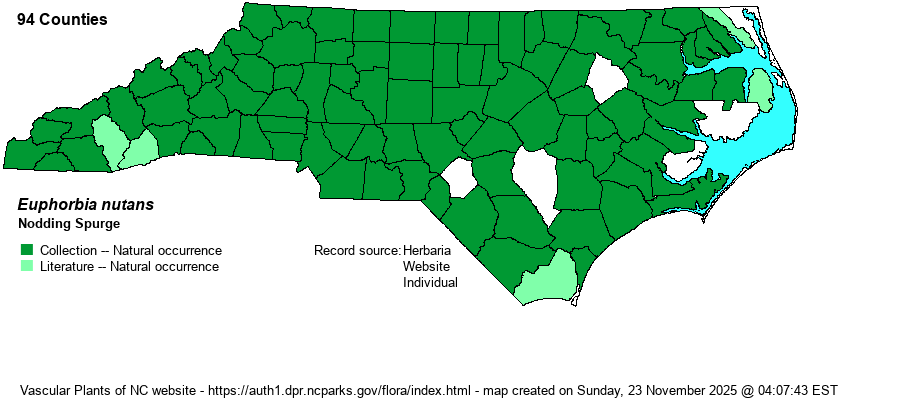| Author | Lagasca & Segura | |
| Distribution | Essentially throughout the state, but no records from the Outer Banks or barrier islands, as well as on the nearby mainland south to Pamlico County.
NH to MI and ND, south to northern FL and TX. Introduced essentially worldwide. | |
| Abundance | Common nearly statewide, but rare to absent in the far eastern part of the state, and seemingly less numerous in some southern Mountain counties. | |
| Habitat | Its original habitat is unknown, but today it thrives in all sorts of disturbed situations, usually in sandy or gravelly soil: roadsides, parking lots, railroads, powerlines, clearings, vacant lots, trail sides, gardens, lawns, fields, croplands, etc. |
| Phenology | Flowering and fruiting May-October. | |
| Identification | Nodding Spurge is a familiar weedy species, growing typically 1-2 feet tall, usually widely branched, with relatively few lance-elliptic to oblong, slightly toothed leaves. Leaves are up to 1.5 inches long and usually have a red central blotch; some plants may lack these spots. The upper part of the stem usually is pubescent. The flowers are very small (with white glandular appendages) and at the ends of branches and also in leaf axils. If the leaves have the purple spots in the center, it is hard to mistake. Even without these spots, it should be recognized by the reddish branches; opposite, oblong leaves with small serrations; and numerous tiny flowers at the tips of branches. E. maculata is similar but is a prostrate species, not erect. | |
| Taxonomic Comments | Various names have been applied to it, including E. preslii, and erroneously E. maculata (as done by RAB 1968).
| |
| Other Common Name(s) | Eyebane Spurge | |
| State Rank | S5 | |
| Global Rank | G5 | |
| State Status | | |
| US Status | | |
| USACE-agcp | FACU link |
| USACE-emp | FACU link |

